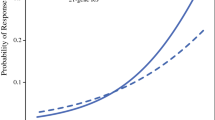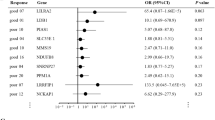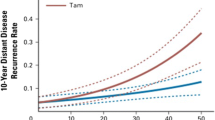Abstract
Approximately 30% of patients with estrogen receptor (ER) positive breast cancers exhibit de novo or intrinsic resistance to endocrine therapies. The purpose of this study was to define genes that distinguish ER+ resistant from ER+ responsive tumors, prior to the start of hormone therapies. Previously untreated post-menopausal patients with ER+ breast cancers were treated for 4 months in a neoadjuvant setting with the aromatase inhibitor exemestane alone, or in combination with the antiestrogen tamoxifen. Matched pre- and post-treatment tumor samples from the same patient, were analyzed by gene expression profiling and were correlated with response to treatment. Genes associated with tumor shrinkage achieved by estrogen blockade therapy were identified, as were genes associated with resistance to treatment. Prediction Analysis of Microarrays (PAM) identified 50 genes that can predict response or intrinsic resistance to neoadjuvant endocrine therapy of ER+ tumors, 8 of which have been previously implicated as useful biomarkers in breast cancer. In summary, we identify genes associated with response to endocrine therapy that may distinguish ER+, hormone responsive breast cancers, from ER+ tumors that exhibit intrinsic or de novo resistance. We suggest that the estrogen signaling pathway is aberrant in ER+ tumors with intrinsic resistance. Lastly, the studies show upregulation of a “lipogenic pathway” in non-responsive ER+ tumors that may serve as a marker of intrinsic resistance. This pathway may represent an alternative target for therapeutic intervention.






Similar content being viewed by others
Abbreviations
- ER:
-
Estrogen receptors
- PR:
-
Progesterone receptors
- AI:
-
Aromatase inhibitors
- R:
-
Responders
- NR:
-
Non-responders
- PLIN:
-
Perilipin
References
Ingle JN (2005) Endocrine therapy trials of aromatase inhibitors for breast cancer in the adjuvant and prevention settings. Clin Cancer Res 11:900s–905s
Winer EP, Hudis C, Burstein HJ et al (2005) American Society of Clinical Oncology technology assessment on the use of aromatase inhibitors as adjuvant therapy for postmenopausal women with hormone receptor-positive breast cancer: status report 2004. J Clin Oncol 23:619–629
Howell A, Cuzick J, Baum M et al (2005) Results of the ATAC (Arimidex, Tamoxifen, Alone or in Combination) trial after completion of 5 years’ adjuvant treatment for breast cancer. Lancet 365:60–62
Smith IE, Dowsett M, Ebbs SR et al (2005) Neoadjuvant treatment of postmenopausal breast cancer with anastrozole, tamoxifen, or both in combination: the Immediate Preoperative Anastrozole, Tamoxifen, or Combined with Tamoxifen (IMPACT) multicenter double-blind randomized trial. J Clin Oncol 23:5108–5116
Dowsett M, Cuzick J, Howell A, Jackson I (2001) Pharmacokinetics of anastrozole and tamoxifen alone, and in combination, during adjuvant endocrine therapy for early breast cancer in postmenopausal women: a sub-protocol of the ‘Arimidex and tamoxifen alone or in combination’ (ATAC) trial. Br J Cancer 85:317–324
Dowsett M, Haynes BP (2003) Hormonal effects of aromatase inhibitors: focus on premenopausal effects and interaction with tamoxifen. J Steroid Biochem Mol Biol 86:255–263
Jelovac D, Macedo L, Handratta V et al (2004) Effects of exemestane and tamoxifen in a postmenopausal breast cancer model. Clin Cancer Res 10:7375–7381
Zaccheo T, Giudici D, Di Salle E (1993) Inhibitory effect of combined treatment with the aromatase inhibitor exemestane and tamoxifen on DMBA-induced mammary tumors in rats. J Steroid Biochem Mol Biol 44:677–680
Hutson PR, Love RR, Havighurst TC, Rogers E, Cleary JF (2005) Effect of exemestane on tamoxifen pharmacokinetics in postmenopausal women treated for breast cancer. Clin Cancer Res 11:8722–8727
Love RR, Hutson PR, Havighurst TC, Cleary JF (2005) Endocrine effects of tamoxifen plus exemestane in postmenopausal women with breast cancer. Clin Cancer Res 11:1500–1503
Rivera E, Valero V, Francis D et al (2004) Pilot study evaluating the pharmacokinetics, pharmacodynamics, and safety of the combination of exemestane and tamoxifen. Clin Cancer Res 10:1943–1948
Spoelstra NS, Manning NG, Higashi Y et al (2006) The transcription factor ZEB1 is aberrantly expressed in aggressive uterine cancers. Cancer Res 66:3893–3902
Russell TD, Palmer CA, Orlicky DJ et al (2007) Cytoplasmic lipid droplet accumulation in developing mammary epithelial cells: roles of adipophilin and lipid metabolism. J Lipid Res 48:1463–1475
Londos C, Brasaemle DL, Gruia-Gray J et al (1995) Perilipin: unique proteins associated with intracellular neutral lipid droplets in adipocytes and steroidogenic cells. Biochem Soc Trans 23:611–615
Brasaemle DL, Barber T, Wolins NE, Serrero G, Blanchette-Mackie EJ, Londos C (1997) Adipose differentiation-related protein is an ubiquitously expressed lipid storage droplet-associated protein. J Lipid Res 38:2249–2263
Richer JK, Jacobsen BM, Manning NG, Abel MG, Wolf DM, Horwitz KB (2002) Differential gene regulation by the two progesterone receptor isoforms in human breast cancer cells. J Biol Chem 277:5209–5218
Horwitz KB, McGuire WL (1975) Predicting response to endocrine therapy in human breast cancer: a hypothesis. Science 189:726–727
McGuire WL, Clark GM (1983) The prognostic role of progesterone receptors in human breast cancer. Semin Oncol 10:2–6
Cui X, Schiff R, Arpino G, Osborne CK, Lee AV (2005) Biology of progesterone receptor loss in breast cancer and its implications for endocrine therapy. J Clin Oncol 23:7721–7735
Osborne CK, Schiff R, Arpino G, Lee AS, Hilsenbeck VG (2005) Endocrine responsiveness: understanding how progesterone receptor can be used to select endocrine therapy. Breast 14:458–465
Singh M, Capocelli KE, Marks JL, Schleicher RB, Finlayson CA, Seligman PA (2005) Expression of vascular endothelial growth factor and proliferation marker MIB1 are influenced by neoadjuvant chemotherapy in locally advanced breast cancer. Appl Immunohistochem Mol Morphol 13:147–156
Burcombe R, Wilson GD, Dowsett M et al (2006) Evaluation of Ki-67 proliferation and apoptotic index before, during and after neoadjuvant chemotherapy for primary breast cancer. Breast Cancer Res 8:R31
Ellis MJ, Tao Y, Young O et al (2006) Estrogen-independent proliferation is present in estrogen-receptor HER2-positive primary breast cancer after neoadjuvant letrozole. J Clin Oncol 24:3019–3025
Dowsett M, Smith IE, Ebbs SR et al (2006) Proliferation and apoptosis as markers of benefit in neoadjuvant endocrine therapy of breast cancer. Clin Cancer Res 12:1024s–1030s
Mackay AG, Urruticoechea A, Dixon JM et al (2007) Molecular response to aromatase inhibitor treatment in primary breast cancer. Breast Cancer Res 9:R37
Li XH, Ong DE (2003) Cellular retinoic acid-binding protein II gene expression is directly induced by estrogen, but not retinoic acid, in rat uterus. J Biol Chem 278:35819–35825
McPherson LA, Woodfield GW, Weigel RJ (2007) AP2 transcription factors regulate expression of CRABPII in hormone responsive breast carcinoma. J Surg Res 138:71–78
Sheth SS, Bodnar JS, Ghazalpour A et al (2006) Hepatocellular carcinoma in Txnip-deficient mice. Oncogene 25:3528–3536
Goldberg SF, Miele ME, Hatta N et al (2003) Melanoma metastasis suppression by chromosome 6: evidence for a pathway regulated by CRSP3 and TXNIP. Cancer Res 63:432–440
Deroo BJ, Hewitt SC, Peddada SD, Korach KS (2004) Estradiol regulates the thioredoxin antioxidant system in the mouse uterus. Endocrinology 145:5485–5492
Swinnen JV, Brusselmans K, Verhoeven G (2006) Increased lipogenesis in cancer cells: new players, novel targets. Curr Opin Clin Nutr Metab Care 9:358–365
Suzuki T, Hayashi S, Miki Y et al (2006) Peroxisome proliferator-activated receptor gamma in human breast carcinoma: a modulator of estrogenic actions. Endocr Relat Cancer 13:233–250
Kinlaw WB, Quinn JL, Wells WA, Roser-Jones C, Moncur JT (2006) Spot 14: a marker of aggressive breast cancer and a potential therapeutic target. Endocrinology 147:4048–4055
Wells WA, Schwartz GN, Morganelli PM, Cole BF, Gibson JJ, Kinlaw WB (2006) Expression of “Spot 14” (THRSP) predicts disease free survival in invasive breast cancer: immunohistochemical analysis of a new molecular marker. Breast Cancer Res Treat 98:231–240
Perou CM, Sorlie T, Eisen MB et al (2000) Molecular portraits of human breast tumours. Nature 406:747–752
Londos C, Brasaemle DL, Schultz CJ, Segrest JP, Kimmel AR (1999) Perilipins, ADRP, and other proteins that associate with intracellular neutral lipid droplets in animal cells. Semin Cell Dev Biol 10:51–58
McManaman JL, Reyland ME, Thrower EC (2006) Secretion and fluid transport mechanisms in the mammary gland: comparisons with the exocrine pancreas and the salivary gland. J Mammary Gland Biol Neoplasia 11:249–268
Doane AS, Danso M, Lal P et al (2006) An estrogen receptor-negative breast cancer subset characterized by a hormonally regulated transcriptional program and response to androgen. Oncogene 25:3994–4008
Farmer P, Bonnefoi H, Becette V et al (2005) Identification of molecular apocrine breast tumours by microarray analysis. Oncogene 24:4660–4671
Morris KT, Toth-Fejel S, Schmidt J, Fletcher WS, Pommier RF (2001) High dehydroepiandrosterone-sulfate predicts breast cancer progression during new aromatase inhibitor therapy and stimulates breast cancer cell growth in tissue culture: a renewed role for adrenalectomy. Surgery 130:947–953
Bajetta E, Zilembo N, Noberasco C et al (1997) The minimal effective exemestane dose for endocrine activity in advanced breast cancer. Eur J Cancer 33:587–591
Garcia-Velasco JA, Moreno L, Pacheco A et al (2005) The aromatase inhibitor letrozole increases the concentration of intraovarian androgens and improves in vitro fertilization outcome in low responder patients: a pilot study. Fertil Steril 84:82–87
Ariazi EA, Leitao A, Oprea TI et al (2007) Exemestane’s 17-hydroxylated metabolite exerts biological effects as an androgen. Mol Cancer Ther 6:2817–2827
Andre F, Hatzis C, Anderson K et al (2007) Microtubule-associated protein-tau is a bifunctional predictor of endocrine sensitivity and chemotherapy resistance in estrogen receptor-positive breast cancer. Clin Cancer Res 13:2061–2067
Brodie A, Sabnis G, Macedo L (2007) Xenograft models for aromatase inhibitor studies. J Steroid Biochem Mol Biol 106:119–124
Martens JW, Nimmrich I, Koenig T et al (2005) Association of DNA methylation of phosphoserine aminotransferase with response to endocrine therapy in patients with recurrent breast cancer. Cancer Res 65:4101–4117
Chatterjee SK, Zetter BR (2005) Cancer biomarkers: knowing the present and predicting the future. Future Oncol 1:37–50
de Silva Rudland S, Martin L, Roshanlall C et al (2006) Association of S100A4 and osteopontin with specific prognostic factors and survival of patients with minimally invasive breast cancer. Clin Cancer Res 12:1192–1200
Martinetti A, Bajetta E, Ferrari L et al (2004) Osteoprotegerin and osteopontin serum values in postmenopausal advanced breast cancer patients treated with anastrozole. Endocr Relat Cancer 11:771–779
Foldi M, Stickeler E, Bau L et al (2007) Transketolase protein TKTL1 overexpression: a potential biomarker and therapeutic target in breast cancer. Oncol Rep 17:841–845
Guerreiro Da Silva ID, Hu YF, Russo IH et al (2000) S100P calcium-binding protein overexpression is associated with immortalization of human breast epithelial cells in vitro and early stages of breast cancer development in vivo. Int J Oncol 16:231–240
Russo J, Hu YF, Silva ID, Russo IH (2001) Cancer risk related to mammary gland structure and development. Microsc Res Tech 52:204–223
Schor AP, Carvalho FM, Kemp C, Silva ID, Russo J (2006) S100P calcium-binding protein expression is associated with high-risk proliferative lesions of the breast. Oncol Rep 15:3–6
Koltzscher M, Neumann C, Konig S, Gerke V (2003) Ca2+-dependent binding and activation of dormant ezrin by dimeric S100P. Mol Biol Cell 14:2372–2384
Mousses S, Bubendorf L, Wagner U et al (2002) Clinical validation of candidate genes associated with prostate cancer progression in the CWR22 model system using tissue microarrays. Cancer Res 62:1256–1260
Arumugam T, Simeone DM, Van Golen K, Logsdon CD (2005) S100P promotes pancreatic cancer growth, survival, and invasion. Clin Cancer Res 11:5356–5364
Taguchi A, Blood DC, del Toro G et al (2000) Blockade of RAGE-amphoterin signalling suppresses tumour growth and metastases. Nature 405:354–360
Nowotny M, Spiechowicz M, Jastrzebska B, Filipek A, Kitagawa K, Kuznicki J (2003) Calcium-regulated interaction of Sgt1 with S100A6 (calcyclin) and other S100 proteins. J Biol Chem 278:26923–26928
Dowen SE, Crnogorac-Jurcevic T, Gangeswaran R et al (2005) Expression of S100P and its novel binding partner S100PBPR in early pancreatic cancer. Am J Pathol 166:81–92
Bray JD, Jelinsky S, Ghatge R et al (2005) Quantitative analysis of gene regulation by seven clinically relevant progestins suggests a highly similar mechanism of action through progesterone receptors in T47D breast cancer cells. J Steroid Biochem Mol Biol 97:328–341
Kristensen VN, Sorlie T, Geisler J et al (2005) Effects of anastrozole on the intratumoral gene expression in locally advanced breast cancer. J Steroid Biochem Mol Biol 95:105–111
Acknowledgments
This work was funded by a Department of Defense Clinical Bridge Award DAMD17-02-1-0353 (to J.K.R.); the National Institutes of Health (National Research Service Award F32 CA103511); United Negro College Fund/Pfizer grant (to D.M.E.H.); the National Institutes of Health Grant (RO1 CA26869), the National Foundation of Cancer Research, the Avon Foundation, and the Breast Cancer Research Foundation (to K.B.H.); and the National Institutes of Health Awards; R01-HD045962, P01-HD38129, R21-HD050863 (J.L.M.).
We acknowledge use of the University of Colorado Cancer Center Microarray Core and Computational Bioscience Program. We thank Carrie Greenwood for performing perilipin immunostaining.
Author information
Authors and Affiliations
Corresponding author
Additional information
A commentary to this article is available at 10.1007/s10549-008-9923-6.
Electronic supplementary material
Rights and permissions
About this article
Cite this article
Harvell, D.M.E., Spoelstra, N.S., Singh, M. et al. Molecular signatures of neoadjuvant endocrine therapy for breast cancer: characteristics of response or intrinsic resistance. Breast Cancer Res Treat 112, 475–488 (2008). https://doi.org/10.1007/s10549-008-9897-4
Received:
Accepted:
Published:
Issue Date:
DOI: https://doi.org/10.1007/s10549-008-9897-4




